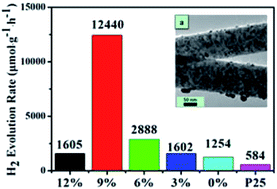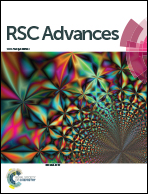TiO2–Au composite nanofibers for photocatalytic hydrogen evolution
Abstract
TiO2-based materials for photocatalytic hydrogen (H2) evolution have attracted much interest as a renewable approach for clean energy applications. TiO2–Au composite nanofibers (NFs) with an average fiber diameter of ∼160 nm have been fabricated by electrospinning combined with calcination treatment. In situ reduced gold nanoparticles (NPs) with uniform size (∼10 nm) are found to disperse homogenously in the TiO2 NF matrix. The TiO2–Au composite NFs catalyst can significantly enhance the photocatalytic H2 generation with an extremely high rate of 12 440 μmol g−1 h−1, corresponding to an adequate apparent quantum yield of 5.11% at 400 nm, which is 25 times and 10 times those of P25 (584 μmol g−1 h−1) and pure TiO2 NFs (1254 μmol g−1 h−1), respectively. Furthermore, detailed studies indicate that the H2 evolution efficiency of the TiO2–Au composite NF catalyst is highly dependent on the gold content. This work provides a strategy to develop highly efficient catalysts for H2 evolution.



 Please wait while we load your content...
Please wait while we load your content...